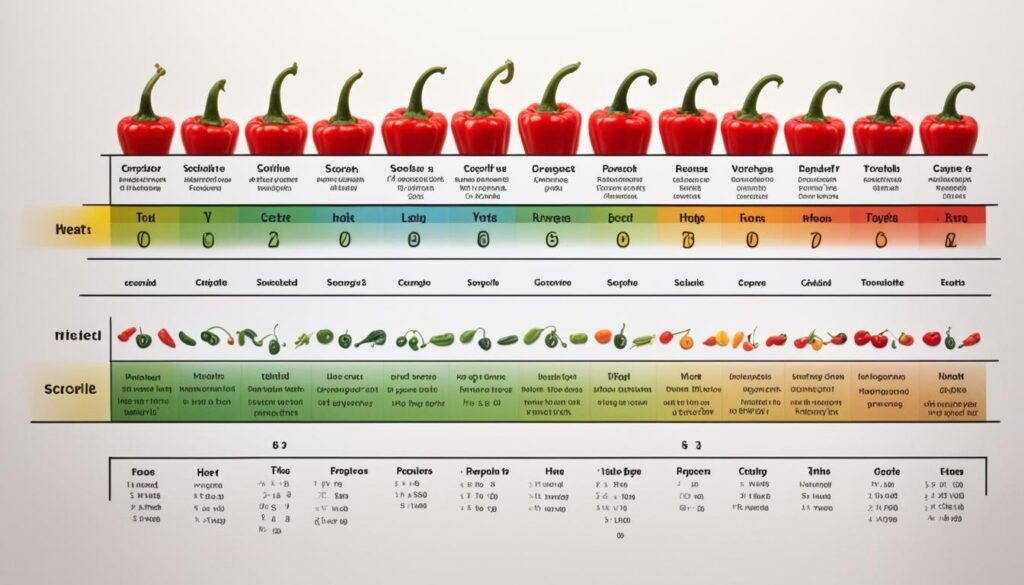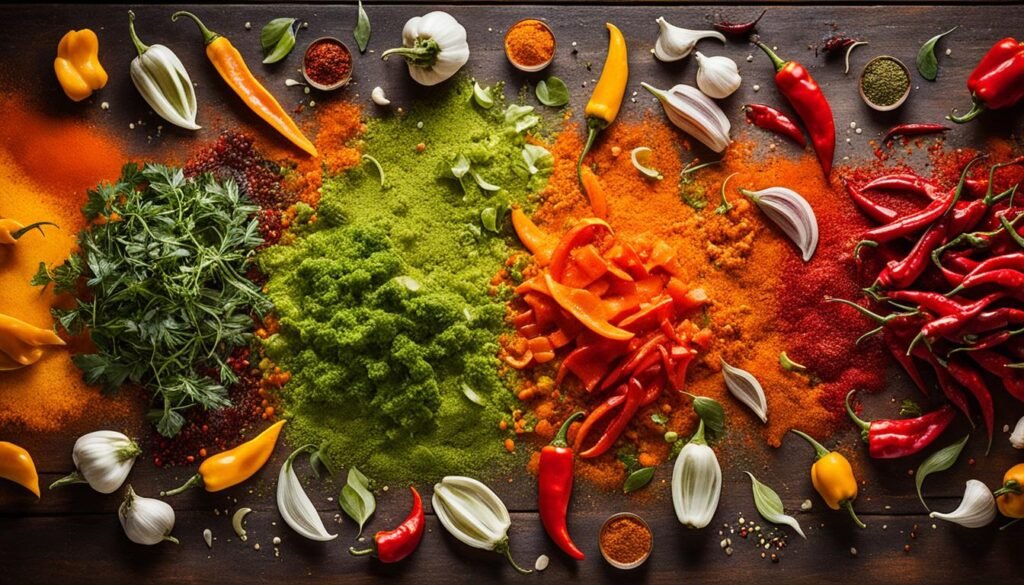Culinary Connoisseurs, Delight in the Complexity of Types of Hot Sauce
Do you love spice and all things hot? Are you ready to explore the world of SIANG JI ASIA SAUCE Types of Hot Sauce? From the smoky tik of chipotle to the boldness of habanero, hot sauce comes in many flavors. It’s a unique journey into tastes that excite and flavors that thrill. Let’s uncover the story, regions, and craft behind this global favorite.
Key Takeaways
- Discover the ancient origins of Types of Hot Sauce, tracing the cultural significance of chili peppers.
- Explore the impact of the Columbian Exchange on the global spread and evolution of Types of Hot Sauce.
- Understand the Scoville scale and how it helps navigate the heat spectrum of Types of Hot Sauce.
- Indulge in the diverse regional flavors of Types of Hot Sauce, from North American classics to Latin American fusions.
- Appreciate the artistry and craftsmanship behind the creation of exceptional Types of Hot Sauce.
Types of Hot Sauce – The Fiery Origins of Hot Sauce
The story of Chili Peppers and hot sauce begins in the cooking of old civilizations. These spicy capsules, first found in the Americas, were treasured for both their heat and healing power in Ancient Civilizations. When the Columbian Exchange bridged the Old and New Worlds, it started a worldwide hot sauce adventure. This changed the Culinary Heritage and Spice History of many cultures.
Ancient Civilizations and the Chili Pepper’s Cultural Significance
Long before Europe found the Americas, Chili Peppers were important in the diets and customs of Ancient Civilizations across the Americas. The Aztecs, Mayans, and Incas valued these spicy fruits for more than just their taste. They used them to make food taste better, last longer, and even as medicine.
The Columbian Exchange and the Global Spread of Chili Peppers
The Columbian Exchange marked a turning point for Chili Peppers and hot sauce. This event saw the exchange of plants, animals, and knowledge between the East and West hemispheres. Explorers brought back the Chili Peppers and spread them around the globe. This sharing of Chili Peppers led to the creation of many local hot sauce types. It mixed the flavors of Chili Peppers with unique ingredients, laying the foundation for a rich Culinary Evolution.
“The journey of Chili Peppers and hot sauce is deeply rooted in the culinary heritage of ancient civilizations.”
Today, Chili Peppers and hot sauce are everywhere, with each area adding its own twist. Latin America brings the smoky chipotle, while Asia offers the lively Sriracha. The route of Chili Peppers has greatly influenced the way food is seasoned and enjoyed worldwide.
Types of Hot Sauce – Navigating the Heat: The Scoville Scale
When picking a Types of Hot Sauce, it’s like diving into a science. The Scoville Scale is your map. Thanks to Wilbur Scoville, we can now measure how hot chili peppers and Types of Hot Sauce are. This scale looks at the amount of Capsaicin, the stuff that makes your mouth feel like it’s on fire.
The Scoville Scale uses Scoville Heat Units (SHU) to rate each pepper and Types of Hot Sauce. Ratings go from 0 SHU for the mild bell pepper up to over 2 million SHU for the super hot Carolina Reaper. This system helps lovers of spicy food and Chili Pepper fans pick their perfect level of heat and flavor.
Are you brave or a bit cautious with spicy food? Either way, the Scoville Scale is here to help. It guides you through the many Types of Hot Sauce. From the mild chipotle to the spicy habanero, knowing the Capsaicin level helps you choose wisely. It lets you pick sauces that add excitement to your meals without burning your mouth off.

Next time you shop for Types of Hot Sauce, use the Scoville Scale. It will lead you to the just-right mix of taste and heat. With it, you’ll discover amazing new flavors that make eating an adventure.
Types of Hot Sauce – A World of Flavors: Regional Hot Sauce Varieties
If you love food, exploring regional hot sauces is a must. You can start with the classic Louisiana style in North America. Or dive into Latin America’s vibrant flavors. Each region brings its unique taste to the hot sauce table.
North American Classics: Louisiana Style and Tabasco
In North America, hot sauce is a big deal, especially in Louisiana. The Louisiana style hot sauce is famous for its mix of cayenne peppers, vinegar, and salt. Brands like Tabasco are well known. They offer a great mix of heat and flavor. This makes them a favorite for many dishes.
Latin American Diversity: Smoky Chipotle to Fruity Habanero
Traveling south, you’ll find a burst of Latin American hot sauces. Mexico brings smoky chipotle sauces. Then the Caribbean adds the hot and fruity habanero sauces. These showcase the rich variety of regional cuisines and cultures.
Asian Fusion: Thailand’s Sriracha and Beyond
Head East for a taste of Asia’s spice traditions. Here, hot sauces combine heat and flavor perfectly. Such as Sriracha from Thailand. It has a famous garlic-forward taste. It’s versatile on many dishes. Asia has a lot more to offer, many of which will surprise and delight your taste buds.
African Heat: Peri Peri and Robust Flavors
Africa introduces us to spicy peri peri sauces. They use the African bird’s eye chili. These sauces are not just hot but also full of deep flavors. They show us the amazing taste combinations possible in regional hot sauce making.
European Influences: Piri Piri and the Portuguese Connection
Europe might not be the first place you think of for hot sauces. But they’ve added their own flavors to the mix. For example, piri piri sauce is a hit, made famous by the Portuguese. This shows how the love for hot sauces spreads across cultures.
Ingredients and Craftsmanship: The Art of Hot Sauce Making
At its core, each Types of Hot Sauce is a blend of carefully chosen ingredients. These help bring out unique flavors. They might include the best Hot Sauce Ingredients, a mix of acid from vinegar and lemon, and a dash of sweetness. Every part creates the rich Flavor Profiles that we love in Types of Hot Sauce.
Developing Types of Hot Sauce is like an art, mixing flavors and heat perfectly. It can be done in many ways. Some use old, secret family methods, while others favor newer ways that make lots of sauce quickly and consistently.
For some, the secret is in the old ways. They use Fermentation, letting ingredients like peppers change over time. This adds deep flavors. Family recipes in many places carry stories of pride and tradition.
Then there’s the modern way, blending old craftsmanship with new tech. Thanks to Industrial Production, we get Types of Hot Sauce made the same every time, and safe too. This mix makes every Hot Sauce Type something to be treasured and tasted.
| Traditional Hot Sauce Making | Industrial Hot Sauce Production |
|---|---|
| Relies on time-honored recipes and techniques passed down through generations | Leverages modern manufacturing processes to ensure consistent quality and safety |
| Utilizes the ancient art of fermentation to develop complex flavors | Emphasizes rigorous Quality Control measures to meet brand standards |
| Reflects the cultural heritage and pride of the creators | Enables mass production and broad distribution of Types of Hot Sauce |

“The art of crafting the perfect Types of Hot Sauce is a delicate balance of science and passion, where every ingredient is carefully selected and meticulously blended to create a flavor symphony that tantalizes the senses.”
Culinary Connoisseurs, Delight in the Complexity of Types of Hot Sauce
The world of Types of Hot Sauce excites both Culinary Connoisseurs and Spicy Food Enthusiasts. It introduces us to the variety in Capsaicin Levels and intriguing Flavor Profiles. Every Hot Sauce Variety narrates a unique story, reflecting its origin and the craftsperson behind it.
Through the Scoville Heat Scale, Culinary Connoisseurs embark on a captivating journey. They can uncover what makes each Types of Hot Sauce different. It could be the rich smokiness of a Chipotle Pepper mix or the refreshing tang of a citrus-infused blend.
If one is eager for deeper exploration, the array of Chili Pepper Varieties awaits. Varieties range from habanero‘s earthy tones to serrano‘s fruity nuances. In each Artisanal Hot Sauce, the Capsaicin Levels and Flavor Profiles are beautifully evident.
| Hot Sauce Variety | Chili Pepper Variety | Scoville Heat Scale | Flavor Profile |
|---|---|---|---|
| Sriracha | Red Jalapeño | 1,000 – 2,500 SHU | Garlicky, Slightly Sweet |
| Cholula | Arbol Chili | 3,000 – 4,000 SHU | Mild, Tangy, Slightly Fruity |
| Frank’s RedHot | Cayenne Pepper | 450 – 2,500 SHU | Vinegar-Based, Bold |
| Tapatio | Serrano Pepper | 2,000 – 3,500 SHU | Tangy, Slightly Spicy |
For Culinary Connoisseurs and Spicy Food Enthusiasts, exploring Types of Hot Sauce is thrilling. They unearth a spectrum of flavors, each presenting the creativity of its maker. From the intense heat of habanero to the rich blend of ginger, culinary possibilities are vast.
“The beauty of Types of Hot Sauce is in their power to elevate a dish. They open a door to diverse culinary traditions. This reflects the creativity and craft of those who create them.”
Conclusion
In the hot sauce world, there’s a sauce for everyone. Exploring the Types of Hot Sauce is fun and not just about food. Making your own lets you create something that truly fits your taste.
The future of hot sauces is looking bright. There’s a growing love for them, and people want new Types of Hot Sauce. Whether you’re new or love spicy foods, there’s so much out there to try.
Chili peppers started it all. Now, Types of Hot Sauce are enjoyed worldwide. The Scoville scale and unique flavors show how exciting the hot sauce world is.
